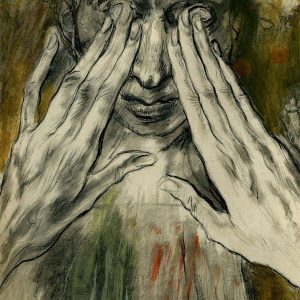
They came to Bethsaida, and some people brought a blind man and begged Jesus to touch him. He took the blind man by the hand and led him outside the village. When he had spit on the man’s eyes and put his hands on him, Jesus asked, “Do you see anything?”
He looked up and said, “I see people; they look like trees walking around.”
Once more Jesus put his hands on the man’s eyes. Then his eyes were opened, his sight was restored, and he saw everything clearly. Jesus sent him home, saying, “Don’t go into the village.”
~ Mark 8:22-26
You are sitting listening to your friends talk excitedly. Jesus has walked into your town. You have heard the stories of what Jesus did in neighboring towns. In one he healed a deaf and dumb man. In another he healed a woman with a menstrual disorder—a nasty condition that no doctor could cure. And you have heard rumors that a little girl was brought back to life. “Certainly Jesus can heal you!” your friends say. But you aren’t sure that you should go with them because you have learned that hope disappoints, and it’s easier not to hope than to feel the sharp pain of loss when your hope is shattered. Your friends beg. You still aren’t sure but you give in.
They lead you through the familiar streets toward Jesus. You can tell by the feel of the path and the turnings of your inner compass that you are headed toward the center of the village. When you arrive you listen intently. You want to know who is there. You hear the voices of several men that you don’t recognize. And you realize from the muffled shuffle of feet on the hard earth that a crowd has gathered. Your friends pull you forward through the throng and you bump into the bodies of those assembled.
The voices stop. You sense the attention of the crowd has turned toward you and at the same moment your friends begin to speak. They beg Jesus to heal their friend; to heal you. You strain to hear Jesus respond, but you don’t hear him give an answer. Instead, you feel a hand take yours; a hand you haven’t felt before. And once again you are led, this time toward the edge of town. You feel your chest tighten. Within the village you are safe. Your inner compass works inside the village. You can always find your way home . . . inside the village. But you have hardly ever gone beyond the last ring of houses. You feel the smooth footpath give way to rough field and you instinctively draw back. The hand doesn’t let go. It doesn’t force you further on, either, but seems to be waiting. Quickly you assess your chances. To go forward might mean healing, but there is danger as well and maybe disappointment. To retreat means safety, but you also recognize it means living the rest of your life with no hope of ever seeing. The gentle hand pulls, gently urging you forward and you give in to its pressure. You count steps so that you will know how far you have gone. Twenty-three, twenty-four—and the hand releases yours. You fight the instinct to reach out. You are afraid that in your urgency to find the hand you might lose your sense of direction. At this point you still know that the village lies behind you.
The one who has led you here is now standing very close. You can feel his warm breath and hear how his body bends the air. You feel the hair at the back of your neck bristle, then you hear the sound of someone spitting and feel the wet spittle on your face. You have been spat at before. But this is different. You feel hands—both hands now—gently hold your face while the thumbs massage the spittle into your closed eyes.
“Do you see anything?” the voice, close to your face, asks.
You look up. Definitely something has happened. You feel like you are able to see, but nothing makes sense. You know something isn’t right. You feel a cold sweat on your forehead. You had tried to keep yourself from hoping, but now you realize how much you have allowed yourself to hope that this man could take your blindness away. You look back toward the village. You see movement. The villagers must have followed you into the field. You try to make sense of what you see. The things moving look like what you imagine trees would look like. You bumped into many tree trunks as you learned to navigate the village. They were hard and solid and straight up and down. What you see matches that. But trees don’t move. People move. But people have faces, arms, and legs. You can’t see anything that looks like a person—only moving trees. Your eyes fill with tears making what you can see one large blur and you wonder if this “half-seeing” might be even worse than not being able to see at all.
“Do you see anything?” the voice asks.
“I see people;” you blurt, “they look like trees walking around.”
Go to the next post in Like Trees Walking series
© Rob Devens 2009 and 2016
